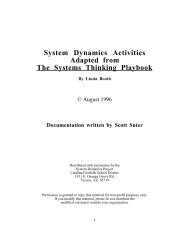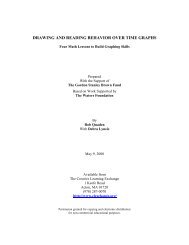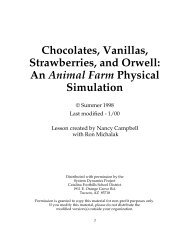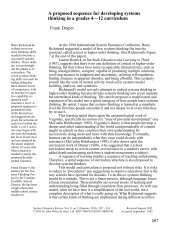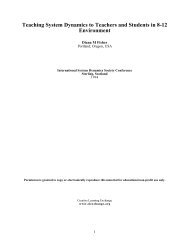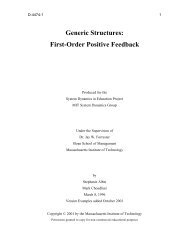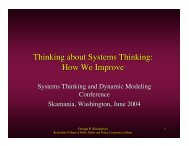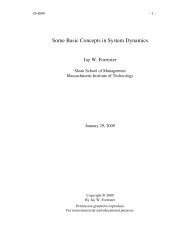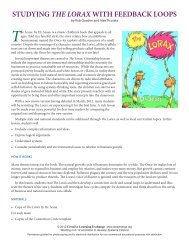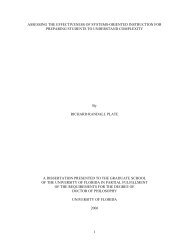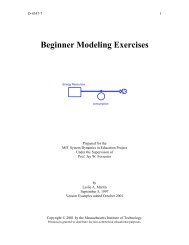Keystone Species in an Ecosystem Using Connection Circles to Tell ...
Keystone Species in an Ecosystem Using Connection Circles to Tell ...
Keystone Species in an Ecosystem Using Connection Circles to Tell ...
Create successful ePaper yourself
Turn your PDF publications into a flip-book with our unique Google optimized e-Paper software.
Precise l<strong>an</strong>guage <strong>an</strong>d clear th<strong>in</strong>k<strong>in</strong>g go h<strong>an</strong>d <strong>in</strong> h<strong>an</strong>d with connection circles.o Elements must be nouns or noun phrases, qu<strong>an</strong>tities that c<strong>an</strong> <strong>in</strong>crease or decreaseover time, like the number of sea otters or the amount of s<strong>an</strong>d deposited.o Do not use words like “more” or “less” <strong>in</strong> the titles.o Remember that elements c<strong>an</strong> be t<strong>an</strong>gible, like the number of fur traders, or<strong>in</strong>t<strong>an</strong>gible, like the desire <strong>to</strong> protect the environment. Often the <strong>in</strong>t<strong>an</strong>giblevariables are keys <strong>to</strong> the problem.o <strong>Connection</strong> circles may vary. The words around each circle do not have <strong>to</strong> be thesame nor <strong>in</strong> the same order, but they should all be th<strong>in</strong>gs that work <strong>to</strong>gether <strong>to</strong>contribute <strong>to</strong> the problem.oStudents are always free <strong>to</strong> ch<strong>an</strong>ge, add or delete elements as they ref<strong>in</strong>e theirth<strong>in</strong>k<strong>in</strong>g.5. Once students have drawn their connection circles with causal arrows, share them as the focusof a class conversation.o Draw a large circle on the board or overhead projec<strong>to</strong>r.o Have each team suggest <strong>an</strong> element <strong>to</strong> put on the circle.o As a class, ref<strong>in</strong>e the list <strong>to</strong> <strong>in</strong>clude no more th<strong>an</strong> five <strong>to</strong> ten elements.o Ask each team <strong>to</strong> describe a causal arrow <strong>an</strong>d expla<strong>in</strong> their reason<strong>in</strong>g for directcausality. Encourage other teams <strong>to</strong> ask clarify<strong>in</strong>g questions. Students should refer <strong>to</strong>the text when expla<strong>in</strong><strong>in</strong>g their reason<strong>in</strong>g.Aga<strong>in</strong>, you may w<strong>an</strong>t <strong>to</strong> review the more detailed <strong>in</strong>structions <strong>in</strong> Lesson 10, “Do You W<strong>an</strong>tFries with That?”Remember, a connection circle is a th<strong>in</strong>k<strong>in</strong>g <strong>to</strong>ol,a way <strong>to</strong> surface <strong>an</strong>d exam<strong>in</strong>e mental models.It is not a mold for one “right” <strong>an</strong>swer.5



